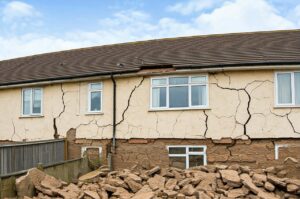As well as tea, football and chicken tikka masala, it is intrinsically British to obsess about property and complain about the weather.
Right now, we have the perfect opportunity to do both. April showers never arrived this year and if this sunny period continues, the sub-soil underneath our feet – and houses – could be desiccating faster than paint under a hairdryer, unleashing a slew of subsidence claims.
Those of a young vintage may remember the blistering hot summer of 1976 when England started to resemble Nevada. Months (and years) later, insurance companies are still dealing with claims for structural damage to property.
I should know, since I started my business in the summer of that year and my office was the upstairs bedroom of a tertiary residential hotel in Golders Green. Since I had no air-conditioning, I was required to sit at my temporary desk in my underwear, it was so stiflingly hot – not a pretty site for clients, I hasten to add!
SHOCK-HORROR STORIES
The ‘S’ word rightly fills house owners with dread. Shock-horror media stories don’t help either, such as the dramatic pictures of giant sinkholes that appeared in Surrey this February.
The Financial Ombudsman Service defines subsidence as: ‘downward movement of the site on which a building stands – where the soil beneath the building’s foundations is unstable’.
This country rests on a ‘base’ of clay and anyone who’s made pottery realises that its stability is affected by water. Other causes of subsidence include tree roots, water leaks, shallow foundations (particularly in Victorian houses) and living on top of a coal mine.
And according to Which magazine ‘Subsidence cover is standard in most policies, but if your property has been previously affected you may find it more difficult to find insurers that will accept you as a customer.’
WHEN THE EARTH MOVES
Some consumers realise that it’s curable and where there’s a will, there’s a way to fix it (such as underpinning). However, in its untreated form it can represent ‘a blight on the sale and value’ of a property.
Building insurance companies are becoming quite leery of offering cover and house owners are hesitant to change building insurance providers when they buy a place.
They’re caught between the proverbial rock and (shifting) hard place – not wishing to be caught in a trap between the old and the new insurers, where both of them blame the other in the desperation to offload any potential liability.
In fact, some properties are so damaged that the whole edifice has had to be rebuilt. For most homebuyers, this would be a horror story. More adventurous buyers of residential property looking for the adrenalin rush are attracted by an ‘appetising’ signed-off insurance claim which can fund refurbishment of a property they really want.
SUBSIDENCE TAKING ROOT
We all love seeing leafy, arboreal streets and gardens for their tremendous amenity value, but trees that get too close to a property drink moisture from the sub-soil and cause more movement. Insurers are not impressed by this and either refuse to provide cover or may charge a hefty premium.
COVER ON SHAKY FOUNDATIONS

Settlement problems can take years to define, and this uncertainty can destabilise the whole buying process.
Diagnosis involves applying glass panels across the cracks, which are then left for a period of time, to demonstrate whether the settlement is old or new.
If this settlement is a recent condition, the owner has the ordeal of trudging their way through a labyrinth of surveyors, structural engineers, quantity surveyors and contractors. The investigation, decision and cost-rectification analysis is a long-drawn-out process.
Saying that, it never did the Leaning Tower of Pisa any harm (probably one of the most viewed buildings in the world).
Closer to home, there’s The Crooked Tea House in Windsor, Berkshire, an eccentric shambles of a building that leans precipitously to one side. It dates back to 1687 and is still functional, although architectural historian Nikolaus Pevsner described its charming angle as ‘an outrageous slant’.
LEANING ON INSURERS
As long as a top-notch subsidence specialist contractor has carried out corrective works to the foundations of a property and given it their seal of approval, purchasers/potential mortgagees can be reassured that they’re buying something that is literally, on solid foundations.
Someone somewhere has to bear the burden of all these properties shifting around and this time it’s Lloyd’s underwriters.
All the claims coming to fruition can amount to hundreds of millions of pounds, if not billions. Premiums could rise, while the shares in this sector will drop. My advice to canny investors is to anticipate this by shorting them.
That’s why I say that subsidence is the sort of house move you want to avoid!
Trevor Abrahmsohn is Founder and Director of Glentree International










